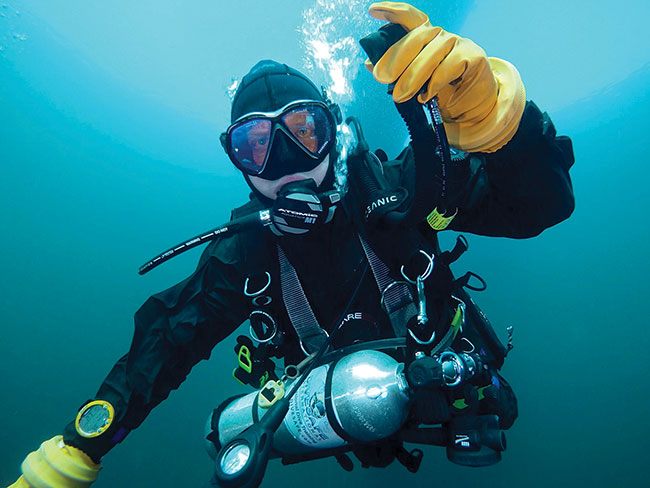
The right tool for the right job
June 24, 2021
By Kelly Korol
Innovations are making diving in aquaculture sites safer than ever, writes Kelly Korol
 Traditional scuba gear has some advantages for mobility and ease of deployment but it is not ideal for work sites where there are entanglements Photos: DiveSafe International
Traditional scuba gear has some advantages for mobility and ease of deployment but it is not ideal for work sites where there are entanglements Photos: DiveSafe International You may have noticed a change in the appearance of aquaculture divers over the past few years. Where it was common to see aquaculture divers dressed in scuba gear on and under the site, you are more likely to see these same divers now attached to a long hose and wearing a full face mask rather than their scuba mask. This new trend in aquaculture diving is called “surface supply diving” and is a mode of diving promoted by the Occupational Health and Safety authorities to make diving safer. Where diving under the nets where entanglement and overhead environments makes diving more hazardous, surface supply can be the right tool for these jobs.
With SCUBA (Self-Contained Underwater Breathing Apparatus), divers must get back to the surface when their tanks get low on air pressure or they are in critical danger of drowning. With surface supply diving, the diver is supplied with air from the surface through a hose. The big difference is that surface supply provides constant, unlimited air supply to the diver thus the risk of the diver running out of air before reaching the surface is greatly reduced. Unlimited air supply has a number of benefits. The diver can go into overhead environments, between nets, close approach to the predator nets without fear of entrapment and running out of air. The diver doesn’t have to concentrate on the status of their air supply pressure and calculate how much longer until they have to head to the surface, instead they can focus on getting the work done.
Surface supply has other advantages as well. If the diver is tethered to the surface with an air hose, simply marry a telephone line to the air hose to have full voice communications between the diver and topside. With “Comms,” the topside supervisor can now speak with the diver, which increases productivity by relaying information and instructions that can be invaluable on rigging or inspection operations. The diver’s breathing is also monitored, and those on the surface are alerted to any distress immediately. Good communications is essential to any job and especially with hazardous environments, like under a fish pen.
Surface supply diving does have some disadvantages in that the diver is not as mobile due to them being attached to an air hose, and there are entanglement or fouling issues with the air hose (divers umbilical). But more often than not, the safety of having unlimited air supersedes the disadvantage. Often, when we think of surface supply diving, we imagine the old hard hat diver in the heavy boots walking on the bottom. Although we still can do that, the surface supply diver can wear lightweight gear and fins and be as nimble and mobile as a scuba diver. The surface supply gear is really an advantage when the diver must pass between the predator net and the cage net when the risk of entanglement is extraordinarily high.
Training for surface supply diving
As you can imagine, surface supply diving has many extra procedures and techniques and therefore requires more training than SCUBA. There are two major levels to surface supply training, Restricted and Unrestricted levels. The restricted level is all that is required for aquaculture diving and it is a no-decompression level. The training can be relatively short and contains the basic knowledge on how to safely use surface supply equipment. The Unrestricted level includes training in subsea power tools, underwater welding and cutting, hyperbarics and is used more for deep and industrial purposes.
Traditional SCUBA has some advantages for diver mobility, portability and ease of deployment but should not be used in overhead environments nor around entanglement hazards that could impede the diver from surfacing when they run low on air. Surface supply diving is better suited for these environments. But, like any tool, both modes of diving have their advantages and disadvantages. It is the job of the dive supervisor to assess the risks and hazards and pick the right tool for the right job.





